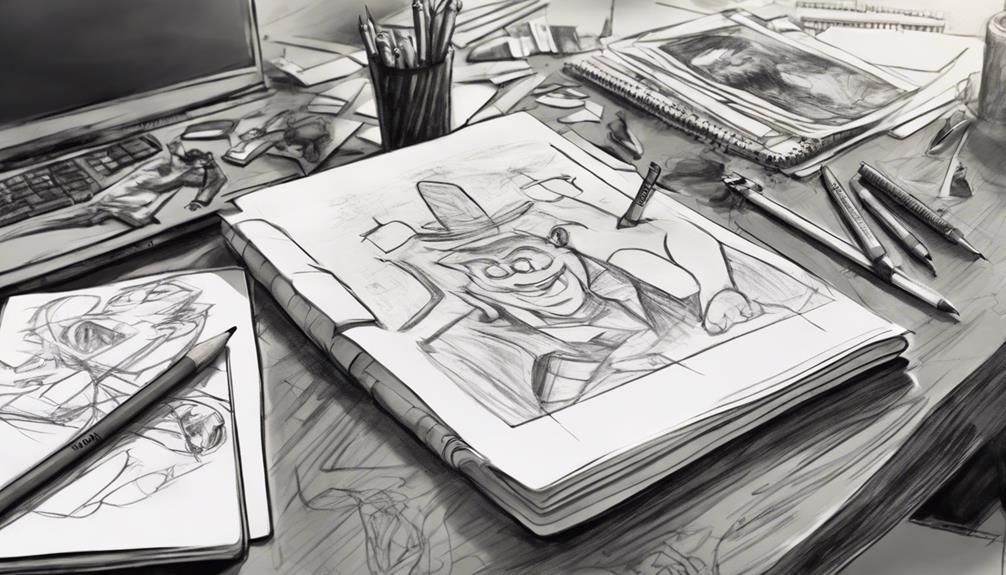3 Essential Hand-Drawn Animation Techniques for Beginners
To get started with hand-drawn animation, you'll need to master three essential techniques. First, understanding motion fundamentals is key – this involves controlling timing and spacing to create a sense of speed, weight, and fluidity. Next, you'll want to learn how to create texture and dimension by using rough sketching techniques, surface detailing, and a range of lines, hatching, and cross-hatching techniques. Finally, crafting consistent animations is vital, which involves maintaining character design consistency, using a consistent color palette, and controlling animation timing. By mastering these techniques, you'll be well on your way to creating engaging animations that capture your audience's attention – and there's more to explore to take your skills to the next level.
Key Takeaways
- Mastering frame progression, timing, and spacing creates a sense of motion and fluidity in hand-drawn animations.
- Squash and stretch, anticipation, and overlap are essential motion principles for creating realistic animations.
- Rough sketching techniques and surface detailing help block out basic forms and add finer details to a scene.
- Controlling line variation, hatching, and cross-hatching techniques creates texture and dimension in hand-drawn animations.
Understanding Motion Fundamentals
Understanding Motion Fundamentals
To create believable motion in hand-drawn animation, you'll need to grasp the fundamental principles that govern how objects move, including the 12 basic principles of animation, which were first introduced by the Disney animators Ollie Johnston and Frank Thomas.
These motion principles are the foundation of creating realistic movement in your animations.
One key aspect to focus on is frame progression, which refers to the way each frame builds upon the previous one to create a sense of motion.
When creating frame progression, you'll want to ponder the timing and spacing of your frames.
Timing refers to the length of time each frame is displayed, while spacing refers to the distance between each frame.
By controlling these elements, you can create a sense of speed, weight, and fluidity in your animations.
Additionally, understanding motion principles such as squash and stretch, anticipation, and overlap will help you create more realistic and engaging animations.
By mastering these fundamental principles, you'll be well on your way to creating convincing and mesmerizing hand-drawn animations.
Creating Texture and Dimension
By incorporating texture and dimension into your hand-drawn animation, you'll be able to create visually rich environments and characters that capture viewers' attention.
To start, try using rough sketching techniques to block out the basic forms and shapes of your scene. This will help you establish the overall composition and layout, making it easier to add texture and dimension later on.
Once you have a solid rough sketch, it's time to start adding surface detailing. This involves adding finer details such as textures, patterns, and other visual elements that give your scene depth and interest.
When adding surface detailing, consider the materials and surfaces you're depicting. For example, if you're drawing a wooden door, think about the grain of the wood, the texture of the panels, and the metal hardware.
Use a range of lines, hatching, and cross-hatching techniques to create a sense of texture and dimension. By paying attention to these details, you'll be able to create a more immersive and engaging animation.
Crafting Consistent Animations
As you shift from creating individual scenes to crafting a cohesive animation, having a consistent visual language and animation style is crucial to maintain viewer engagement. To achieve this, you'll need to manage your time effectively and control the pacing of your animation.
| Consistency Aspect | Description | Tips |
|---|---|---|
| Character Design | Verify characters look the same throughout the animation | Use model sheets to maintain consistency in character design and proportions |
| Color Palette | Maintain a consistent color scheme to create a cohesive look | Limit your color palette to 3-5 main colors and use variations of these colors |
| Animation Timing | Control the pacing of your animation to create a consistent feel | Use a timing chart to plan out the pacing of your animation and make adjustments as needed |
| Backgrounds | Verify backgrounds are consistent in style and quality | Create a library of reusable backgrounds to save time and maintain consistency |
Frequently Asked Questions
What Software Is Best for Hand-Drawn Animation?
When choosing software for hand-drawn animation, you'll want to weigh digital drawing tools that offer intuitive interfaces and robust features. Popular animation apps like Adobe Animate, Toon Boom Harmony, and OpenToonz are great options to explore for beginners.
Can I Animate With a Mouse or Trackpad?
You can animate with a mouse or trackpad, but consider the limitations. Mouse precision is vital for detailed work, while trackpad ergonomics can lead to fatigue. Invest in a graphics tablet for ideal control and comfort.
How Do I Create a Storyboard for Animation?
You'll create a storyboard by sketching key frames, planning your visual pacing, and arranging them in a logical layout, considering timing, camera angles, and character placement to convey your story's flow and rhythm effectively.
What Is the Ideal Frame Rate for Animation?
When animating, you'll want to aim for a frame rate that balances motion blur and frame accuracy. Typically, 24 frames per second (FPS) is considered ideal, as it provides a smooth motion while minimizing blur and maintaining accuracy.
Can I Use a Graphics Tablet for Animation?
When choosing a graphics tablet for animation, consider tablet sensitivity for precise control and drawing ergonomics to prevent fatigue. You'll want to test different models to find one that fits comfortably in your hand and suits your drawing style.
Conclusion
You've now grasped the basics of hand-drawn animation.
By applying motion fundamentals, creating texture and dimension, and crafting consistent animations, you'll bring your characters to life.
Remember to keep your drawings loose and fluid, and don't be afraid to experiment and make mistakes.
Practice these techniques regularly to develop your skills and style.
With dedication and persistence, you'll be well on your way to creating mesmerizing hand-drawn animations.






